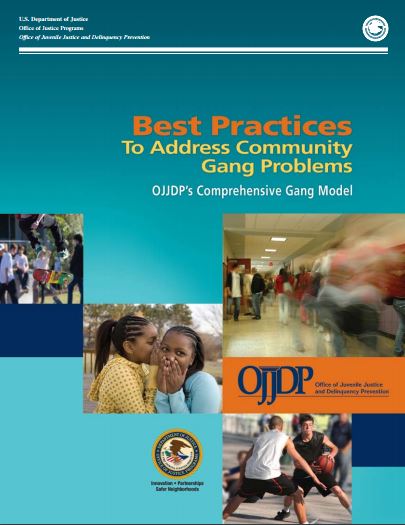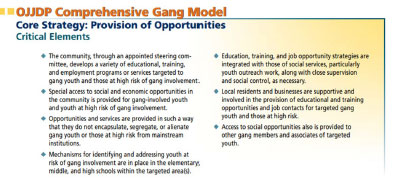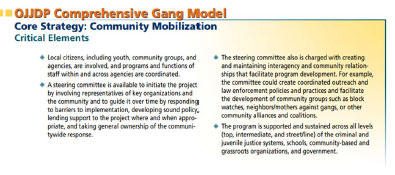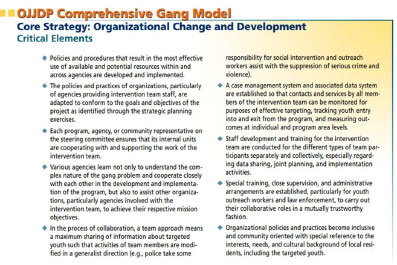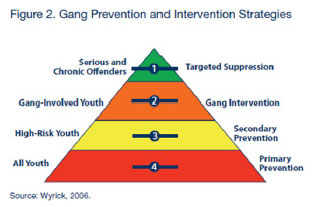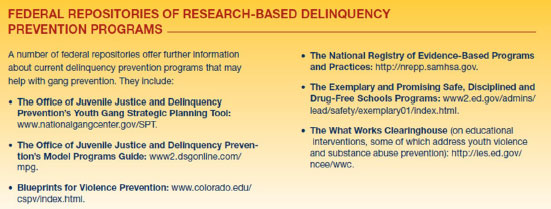What are the Signs?
VERY EARLY YEARS AGES 0-5
- Hypervigilance to threat
- Cognitive impairment, including verbal deficits
- Insecure attachment to a primary caregiver
- Early aggression and acting-out behavior
6 YEARS AND UP
- Antisocial behaviors
- Having been rejected and/or victimized by peers
- Poor parental monitoring
- Alcohol/drug use
- Negative life events
- Mental health problems
- School
- Poor school performance
- Disconnected from school
- Feeling unsafe at school
RISK FACTORS – SPECIFIC TO COMMUNITY
- Many area youth are involved in illegal behavior
- Availability and use of firearms
- Availability and use of drugs
- Low neighborhood attachment
Reducing the Attraction of Gangs
To reduce the attractions of gangs, we must increase the attractiveness of other organizations. Our goal should be to offer youth access to organizations with a solid image and a strong brand or identity that matches or coun-ters the popularity of the neighborhood gangs. Here are four key principles that practitioners and policymakers should keep in mind when developing evidence-based strategies and programs to help prevent gang-joining:
- Promote positive opportunities.
- Train and educate for meaningful employment.
- Ensure an active role for law enforcement.
- Make comprehensive strategies communitywide.
Partnerships
Community partnerships are crucial to reducing the attraction of gangs; these should include youth, their families, law enforcement, public health, schools, faith-based organizations, and groups that offer recreational programs, employment and job-training skills.
Getting Started
To succeed, communities must first assess their gang problem and use that assessment to craft a continuum of responses that are communitywide in scope. These responses should involve the community in planning and delivering prevention and intervention programs and employ integrated outreach, support and services. A balanced approach that incorporates each of these components is most likely to have a significant impact.
Commmunity Assessment
When a community sets out to start a gang prevention/intervention program, it is helpful to begin by conducting a community assessment. Important factors to consider in the needs assessment include:
- Definition of what a gang is
- Locations of gangs
- Identify and target youth who are at greatest risk
- Community deficits
- Community strengths
- Agencies who are involved, and what their roles will be
Consider using the Best Practice to Address Community Gang Problems:
OJJDP’s Comprehensive Gang Model Appendix B
Unlike other initiatives, the lead agency in these multidisciplinary programs does not assume control of the initiative, but instead provides an administrative framework to facilitate the work of the intervention team and the steering committee. A wide variety of agency types have led these initiatives. No matter which agency assumes primary responsibility for this initiative, its credibility and influence within the community are directly correlated to the success of planning and implementation activities. The lead agency has a number of important responsibilities:
Moreover, no programs have been developed specifically to prevent gangs from emerging. In the meantime, to prevent youth from joining gangs, communities must employ multiple strategies and services, including:
- Addressing elevated risk factors for joining a gang
- Strengthening families
- Reducing youth’s conflicts
- Improving community-level supervision of youth
- Providing training for teachers on how to manage disruptive students
- Providing training for parents of disruptive and delinquent youth
- Reviewing and softening school “zero tolerance” policies to reduce suspensions and expulsions
- Ensuring that punitive sanctions target delinquent gang behaviors, not gang apparel, signs, and symbols
- Providing tutoring for students who are performing poorly in school
- Increasing adult supervision of students after school
- Providing interpersonal skills training to students to help resolve conflicts
- Providing a center for youth recreation and referrals for services
- Providing gang awareness training for school personnel, parents, and students
- Teaching students that gangs can be dangerous
- Providing training for school resources officers in mediating conflicts

